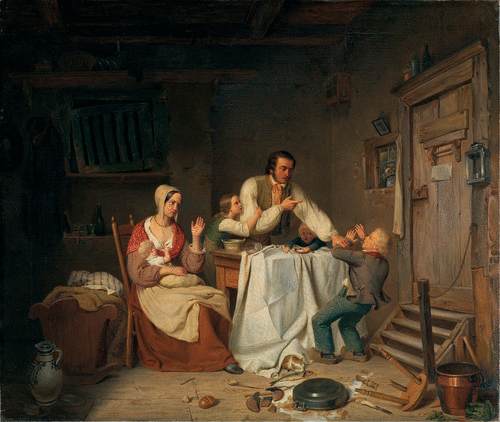Interrupted Meal, by Heinrich von Rustige

Heinrich von Rustige, Unterbrochene Mahlzeit (Interrupted Meal), 1838, oil on canvas, Staatliche Kunsthalle, Karlsruhe, Germany. (Image is in the public domain.)
In 1845, the German psychiatrist Heinrich Hoffmann (1809–1894) published Der Struwwelpeter, a children’s book, translated into more than 40 languages, consisting of 10 stories, illustrated and rhymed, each centered on a different undisciplined child. The aim of the book was to demonstrate the consequences of behaviors of naughty boys and girls, but Hoffmann seems also to illustrate some psychiatric disorders in children. The most famous of them is the main character of Die Geschichte vom Zappel-Philipp or The Story of the Fidgety Philip. A restless boy, who does not want to sit still at dinner, rocks back and forth on his chair and loses his balance, grabs at the tablecloth, and knocks all the food onto the floor, to his parents’ great displeasure. The story of Fidgety Philip is universally acknowledged as the first popular depiction of attention deficit hyperactivity disorder (ADHD) (1). In his verse, Hoffmann well describes the restless and impetuous behavior of the boy: “Fidgety Phil / He won’t sit still / He wriggles / And giggles” at the table, and after the paternal admonition, “The naughty restless child / Growing still more rude and wild.”
Hoffmann may have been inspired by the work of German painter and poet Heinrich von Rustige (1810–1900), who illustrated a very similar scene 7 years earlier, in 1838. In his Interrupted Meal (Unterbrochene Mahlzeit), von Rustige depicts a family belonging to the German small bourgeoisie in the 1800s. Family members seem to wear Sunday clothes, indicating an important event. The room is furnished quite simply and is used for cooking, eating, and sleeping. One of the children disrupts a formal meal with his unruly behavior. As evidenced by the broken stool, the boy has lost his balance and pulled the tablecloth off the table, along with the dishes and food, to the delight of the cat. In the center of the painting, the head of household threatens the misbehaving child. While the mother avoids looking at the scene, the daughter seems to hold her father’s arm. The son may be trying to reach the door, in order to escape his father’s punishment.
Von Rustige’s painting could be one of the first artistic illustrations of ADHD, a disorder first described only at the beginning of the 20th century by the British pediatrician Sir George Still (1868–1941) (2).
1 : Hyperactive children. Sci Am 1970; 222:94–98Crossref, Medline, Google Scholar
2 : Some abnormal psychical conditions in children: excerpts from three lectures. J Atten Disord 2006; 10:126–136Crossref, Medline, Google Scholar



